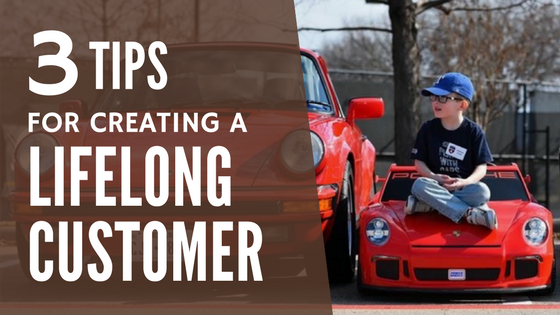3 Tips for Creating a Lifelong Customer from Porsche
/The other day we were talking in the office and Kurt, our Creative Director, shared this picture of his son at a weekend car event. Kurt is a member of PCA (Porsche Club of America) and his son, at a mere 5 years old, is a member of PCA Juniors.
In seeing this picture, I was struck by the pure branding genius of Porsche. Here is a child that has been not only exposed to the brand, but has been immersed in a joyful brand experience very early in his life. This young boy is likely to be a Porsche fan for life – and, more importantly (from a business perspective), a future customer.
“The probability of selling to an existing customer is up to 14 times higher than the probability of selling to a new customer.”
As parents, we enjoy sharing our favorite brands with our kids, and Porsche has made this easy and fun by facilitating a group of young brand enthusiasts. Organizations that can involve both parents and kids help to create memories, connections, and long-term brand love.
By looking at the example of PCA, brands can learn a few tips for how to create a lifelong customer.
1. Make Your Best Customers Feel Special
PCA was started in the early ‘50s by a Porsche owner in the DC area, just because he loved the cars and wanted to meet other Porsche enthusiasts like him. In 1955, the club launched with 13 members and quickly received official recognition as the Porsche Club of America by the Porsche factory.
By encouraging and facilitating the PCA, Porsche allows its customers to feel a personal relationship with the brand. A card-carrying PCA member is granted access to special Porsche events and social activities, which provides a feeling of exclusivity to only the most faithful Porsche fans.
2. Let Your Customers Contribute to the Brand Experience
By 1958, the club had grown to several hundred members and they arranged a trip to the Porsche factory in New York. The factory graciously welcomed PCA members and made a special offer for them to take delivery of a Porsche straight off the line. This proved to be such a popular idea that the tradition is still in place today.
It’s important to note that the PCA and its activities aren’t run by brand executives, it was created by a fan and the endeavor was happily encouraged by the Porsche corporation. If your customers are eager to contribute to the experience of your brand, provide them the opportunity to do so and reward them for it. It will only make them love you more.
3. Reward Your Most Loyal Customers
Today, the PCA has grown to over 100K total members in 144 regional chapters across the country. PCA members receive many perks for being a part of the club, including social events, tech talks, drivers education events, help with technical problems, and more. Kurt especially appreciates receiving special parking and access to Porsche hospitality at races where the brand is participating.
Fans love to receive praise and gratitude when they go out of their way to express affection for their favorite brands. When you have a customer that loves your brand, be open with showing appreciation through gifts, special offers, and a public expression of thanks.
With four generations that have major buying power in the market today, brands have the ability to bring in consumers at a very young age and capitalize on their loyalty as they grow.
How is your brand building lifelong customers? Share your thoughts and ideas in the comments section.
Earning lifelong customers requires a long-term brand strategy.
This starts with building a strong, solid foundation for your brand.
Fill out the form below to download your copy of our Brand Experience Worksheet. This four-page, easy-to-follow worksheet includes questions that will help you clearly articulate the vision for your brand, consider how you want customers to perceive your brand, and craft an experience around your ideal customer.








